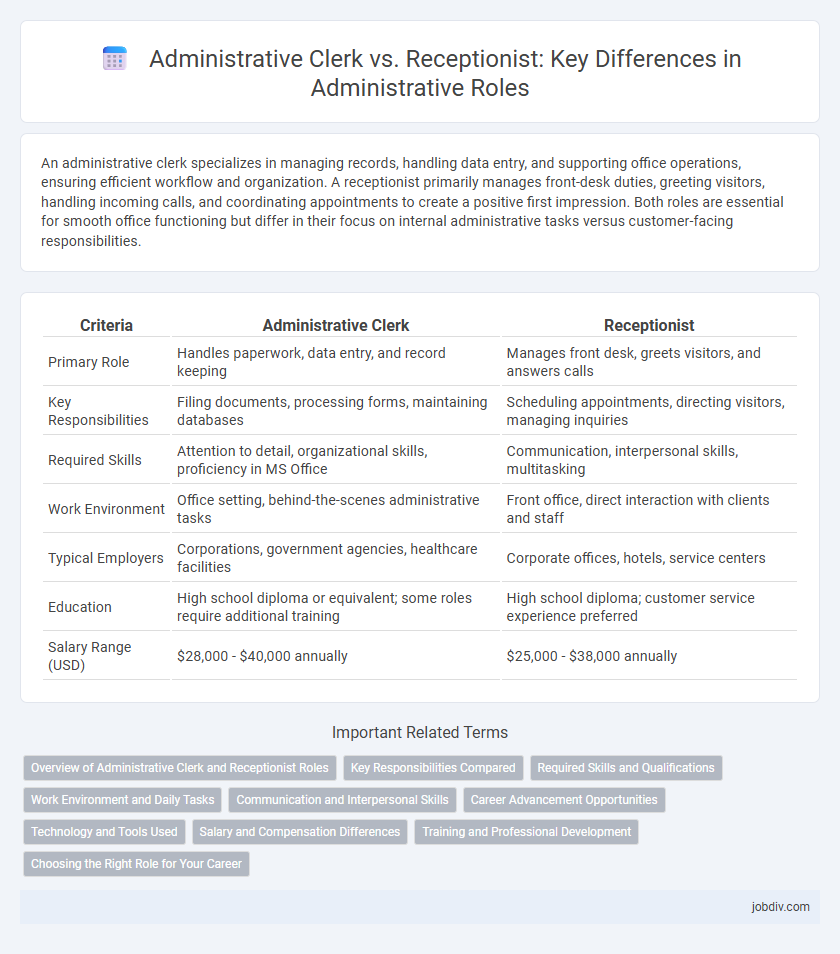An administrative clerk specializes in managing records, handling data entry, and supporting office operations, ensuring efficient workflow and organization. A receptionist primarily manages front-desk duties, greeting visitors, handling incoming calls, and coordinating appointments to create a positive first impression. Both roles are essential for smooth office functioning but differ in their focus on internal administrative tasks versus customer-facing responsibilities.
Table of Comparison
| Criteria | Administrative Clerk | Receptionist |
|---|---|---|
| Primary Role | Handles paperwork, data entry, and record keeping | Manages front desk, greets visitors, and answers calls |
| Key Responsibilities | Filing documents, processing forms, maintaining databases | Scheduling appointments, directing visitors, managing inquiries |
| Required Skills | Attention to detail, organizational skills, proficiency in MS Office | Communication, interpersonal skills, multitasking |
| Work Environment | Office setting, behind-the-scenes administrative tasks | Front office, direct interaction with clients and staff |
| Typical Employers | Corporations, government agencies, healthcare facilities | Corporate offices, hotels, service centers |
| Education | High school diploma or equivalent; some roles require additional training | High school diploma; customer service experience preferred |
| Salary Range (USD) | $28,000 - $40,000 annually | $25,000 - $38,000 annually |
Overview of Administrative Clerk and Receptionist Roles
Administrative clerks manage office tasks such as record keeping, data entry, and scheduling to ensure smooth organizational operations. Receptionists serve as the first point of contact, handling incoming calls, greeting visitors, and managing appointment calendars with strong communication skills. Both roles are essential for efficient office administration, but clerks emphasize internal processes while receptionists focus on external interactions.
Key Responsibilities Compared
Administrative Clerks handle data entry, file management, and document preparation to support office operations efficiently. Receptionists manage front desk duties, including greeting visitors, answering calls, and scheduling appointments to ensure smooth communication flow. Both roles require organizational skills, but Administrative Clerks focus more on back-office tasks while Receptionists prioritize direct interaction and customer service.
Required Skills and Qualifications
Administrative clerks require strong organizational skills, proficiency in office software like Microsoft Office Suite, and knowledge of data entry and record keeping. Receptionists need excellent communication abilities, courteous interpersonal skills, and the capacity to manage multi-line phone systems and schedule appointments efficiently. Both roles often demand basic computer literacy and time management, but administrative clerks typically require more attention to detail and familiarity with filing systems, while receptionists prioritize customer service expertise.
Work Environment and Daily Tasks
Administrative Clerks typically work in office settings managing records, processing documentation, and supporting departmental operations with data entry and correspondence. Receptionists usually operate at the front desk, greeting visitors, handling phone calls, and coordinating appointments in environments such as corporate offices, medical facilities, or hotels. While both roles require strong organizational skills, administrative clerks focus more on internal administrative support, whereas receptionists emphasize customer service and communication with clients or visitors.
Communication and Interpersonal Skills
Administrative Clerks excel in detailed internal communication, organizing records, and coordinating office workflows requiring precise information management. Receptionists specialize in front-desk interactions, handling diverse client inquiries with strong interpersonal skills and a professional demeanor. Both roles demand clear verbal and written communication but differ in public-facing engagement levels and task complexity.
Career Advancement Opportunities
Administrative clerks often have clearer pathways for career advancement within organizational operations, progressing to roles like office manager or administrative supervisor due to their involvement in detailed record-keeping and clerical tasks. Receptionists typically advance into customer service management or front office administration roles, benefiting from their direct interaction with clients and coordination of communication channels. Both positions provide foundational skills for administrative careers but differ in focus areas influencing the nature of advancement opportunities.
Technology and Tools Used
Administrative clerks utilize specialized software like Microsoft Office Suite, database management systems, and enterprise resource planning (ERP) tools to organize records and streamline workflows. Receptionists often employ phone systems, scheduling applications, and visitor management software to manage appointments and front-desk communications efficiently. Both roles increasingly integrate digital communication platforms and cloud-based tools to enhance productivity and data accessibility.
Salary and Compensation Differences
Administrative Clerks typically earn a median salary ranging from $33,000 to $43,000 annually, reflecting their responsibilities in managing office records and supporting management tasks. Receptionists often have a median annual salary between $28,000 and $37,000, with compensation influenced by customer service duties and front-desk interaction. Variations in pay depend on industry, geographic location, and experience, with administrative clerks generally receiving slightly higher wages due to more technical job functions.
Training and Professional Development
Administrative clerks typically undergo specialized training in office software, record management, and organizational skills, which enhances their efficiency in handling administrative tasks. Receptionists receive targeted training in customer service, communication, and phone systems to effectively manage front-desk operations and client interactions. Both roles benefit from ongoing professional development opportunities like workshops and certification programs to stay updated with industry standards and improve career growth.
Choosing the Right Role for Your Career
Choosing between an Administrative Clerk and a Receptionist depends on your career goals and skill set; Administrative Clerks handle data entry, record keeping, and office organization, while Receptionists focus on front-desk duties, customer service, and communication. Administrative Clerks often require proficiency in office software, attention to detail, and multitasking abilities, whereas Receptionists need strong interpersonal skills, phone etiquette, and the ability to manage visitor interactions. Assessing your strengths in administrative tasks versus client-facing roles will help determine the most suitable career path.
Administrative Clerk vs Receptionist Infographic

 jobdiv.com
jobdiv.com